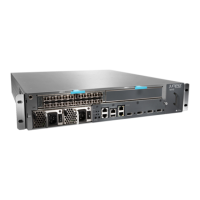Understanding Redundant Power Supplies
•
Redundant Power Supplies Overview on page 608
•
M5/M10 Router Redundant Power Supplies on page 609
•
M7i Router Redundant Power Supplies on page 610
•
M10i Router Redundant Power Supplies on page 610
•
M20 Router Redundant Power Supplies on page 611
•
M40 Router Redundant Power Supplies on page 612
•
M40e Router Power Supplies and Location on page 613
•
M160 Router Redundant Power Supplies on page 615
•
T1600 Redundant Power Supplies on page 616
•
TX Matrix Redundant Power Supplies on page 617
•
TX Matrix Plus Redundant Power Supplies on page 618
Redundant Power Supplies Overview
Inspect redundant power supplies to ensure that they distribute power to the other router
components according to their voltage requirements.
With redundant power supplies, two power supplies are installed in a router and perform
load sharing during normal operation. When one power supply fails or is switched off,
the other power supply immediately and automatically assumes the entire electrical
load. Table 141 on page 608 lists some router characteristics for each M Series router
platform type.
The power supplies are internally connected to the midplane, which delivers the power
input from the circuit breaker box and distributes the different output voltages produced
by the power supplies to the router’s components, depending on their voltage
requirements.
Table 141: Router Power Supply Characteristics per Routing Platform
TX
Matrix/TX
Matrix
Plus
T640/
T1600T320M320M160M120M40eM40M20
M7i/
M10i
M5/
M10
Power
Supply
Characteristic
2224222222/42Number. of
power
supplies
DC
4560 W
DC
9200 W
6500W/
8616
W
DC
enhanced
3200
W
3200
W
DC
enhanced
3200
W
AC 1750
W
DC
2000 W
DC
original
2600 W
DC
enhanced
3200 W
AC 2100
W
DC 2100
W
AC
2900 W
DC
3000 W
1500
W
750 WAC
293 W
DC
DC 293
W
434
W
Watts per
AC/DC power
supply
Copyright © 2012, Juniper Networks, Inc.608
M Series and T Series Routers Monitoring and Troubleshooting Guide

